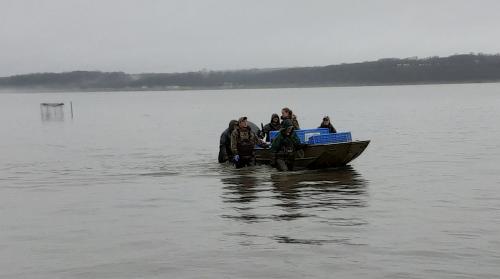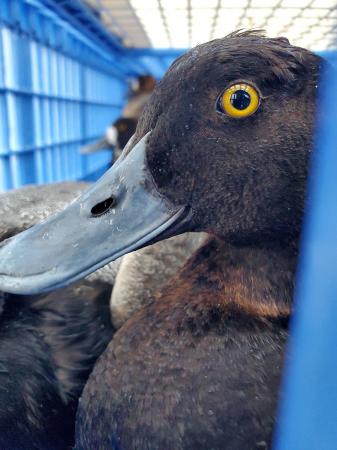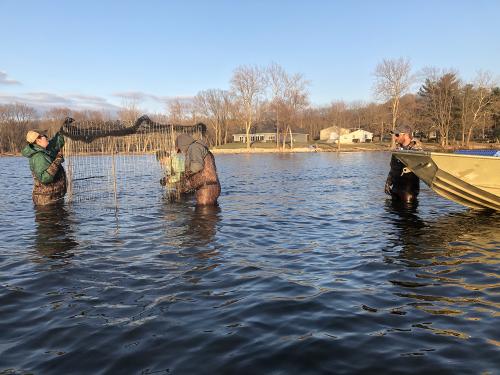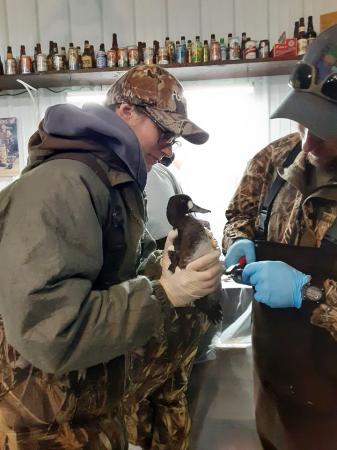Prior to Pandemic, WIU Biology Department Completes Duck Banding Research
April 17, 2020
MACOMB, IL - - This spring, the Western Illinois University Department of Biology offered its students the opportunity to participate and volunteer in duck banding to study lesser scaup.
Lesser scaup, a species of North American diving duck, are studied by the WIU Department of Biology and with the help of volunteers from other organizations like the Illinois, Iowa, Indiana and Minnesota departments of Natural Resources, as well as volunteers from Ducks Unlimited and Delta Waterfowl. In past duck banding seasons, ecology students and research method classes from nearby universities have volunteered their time, along with local hunters and naturalists.
The WIU Department of Biology traps in multiple spots, depending on the year and where the lesser scaup choose to group together. Both sides of the Mississippi River in Illinois and Iowa are scouted by the team before choosing the locations in which to lay traps.
Once the locations are decided, trap sites are marked with bait for the ducks. Swim-in traps are used due to lesser scaup diving for their food. Welded wire, heart-shaped traps are used and lesser scaup follow a trail of bait inside the trap. Once the ducks are inside the traps, they are collected, weighed on shore, their sex is identified and they are released with a leg band to continue migration.
Lauren Larson, a WIU Biology Department graduate assistant, of Owatonna, MN, has been involved in duck banding for two seasons.
"We definitely had to make adjustments in our banding operation due to COVID-19. We had many volunteers that were unable to make it due to concerns with the rising health crisis, which was totally understandable," said Larson. "In the beginning, we limited our help to eight volunteers max per day, but usually only had six until the issuance of the stay-at-home order. Most of these volunteers were locals and came back to help when we were short-handed."
In addition to volunteers not being able to help, the season was stopped early due to the rising concerns of the pandemic and safety concerns. This year, there were an average of six volunteers per day, while duck banding other years had as many as 15 volunteers per day.
"We stopped banding once the stay-at-home order went into effect," she said. "Usually, banding goes on for the entire month of March and even into April. This year we banded for a week and a half, so the time we were able to be in the field was definitely impacted."
Larson, banding coordinator this season, has benefitted in many ways from participating in duck banding.
"Much of what I do as the banding coordinator involves organizing people and equipment, as much as it does making trapping decisions. With banding, there are anywhere from 3-12 new people every day. Some of them have participated in banding before, but some are brand new," said Larson. "It's my responsibility to make sure that everyone receives the necessary training for their own safety and that of the birds."
Larson said she makes sure that the right number of people are going to the right locations with the proper equipment so that banding can be done efficiently.
"While our ultimate goal is to put as many bands out as we can, I also like to make sure our volunteers are learning and enjoying this unique experience," she said. "This opportunity has helped enhance both my communication and public outreach skills, things that will undoubtedly be useful in the future."
One benefit of the banding program is the data that is collected through the process. Data can be added to a duck's record at each recapture, as well as be used by management officials to make informed decisions regarding conservation. During the WIU banding project this year, ducks have been found from Louisiana from 2019 and one that hatched in Montana in 2018.
Banding data can also give management officials information like migration routes taken, survivability rate and harvest rates by hunters. Duck banding information also helps determine bag limits for duck hunting.
Although the purpose of duck banding is trapping, banding and releasing the ducks, some ducks are held onto for further study.
"Part of my master's research involves conducting short-term feeding trials to determine how much energy scaup metabolize from certain foods," said Larson. "These birds are released after their trial to continue migrating. To avoid influencing the banded population data these birds are not banded."
As for the benefits of duck banding, it gives students the opportunity to handle and band birds. Students are able to work with volunteers of multiple organizations, like Ducks Unlimited and individuals from the Department of Natural Resources from multiple states.
"For those interested in pursuing a career involving wildlife, this is a great way to build their resume while networking with professionals in the field," said Larson. "We've had students from several universities volunteer over their spring break. Many members from WIU's chapters of The Wildlife Society and American Fisheries Society have also helped in the past. Students do not need to be a member of either to volunteer."
For more information on the Department of Biology, visit wiu.edu/cas/biological_sciences.
Posted By: Hayley Porter (hp-porter@wiu.edu)
Office of University Communications & Marketing





Connect with us: